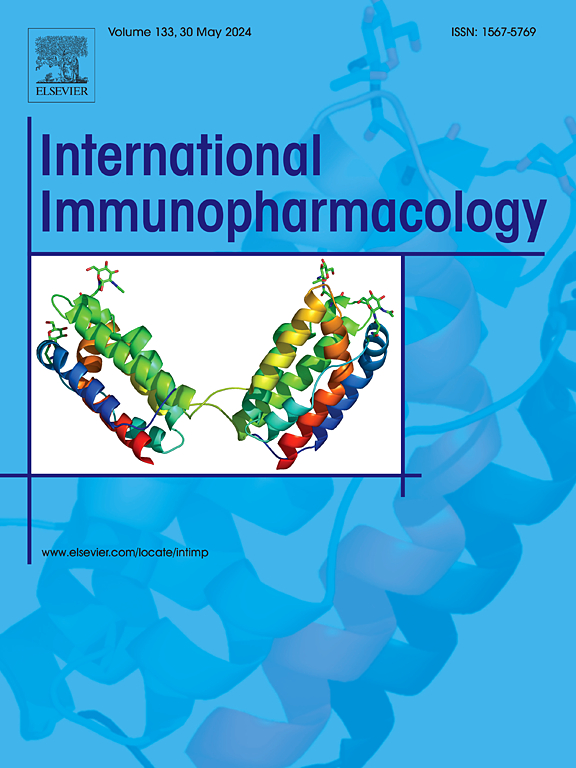TLR4 mediates glucolipotoxicity-induced mitochondrial dysfunction in osteoblasts by enhancing NLRP3-MAVS expression and interaction
IF 4.7
2区 医学
Q2 IMMUNOLOGY
引用次数: 0
Abstract
Mitochondrial dysfunction is a critical mechanism underlying diabetic bone loss, which is driven by the inhibition of osteoblast differentiation due to glucolipotoxicity. The molecular mechanisms through which glucolipotoxicity induces mitochondrial dysfunction remain poorly understood. In this study, we observed an upregulation of Toll-like receptor 4 (TLR4) expression in osteoblasts subjected to glycolipotoxic conditions, which was associated with mitochondrial dysfunction. Proteomic analysis revealed that TLR4 plays a crucial role in glucolipotoxicity and is closely linked to mitochondrial function in osteoblasts. Knockdown of TLR4 was found to alleviate osteoblast differentiation disorders and mitochondrial dysfunction as well as mitochondria-mediated apoptosis induced by glucolipotoxicity. In contrast, overexpression of TLR4 exacerbated the detrimental effects of glucolipotoxicity. Mechanistically, glucolipotoxicity activates TLR4, resulting in increased expression of NLRP3 (NOD-like receptor protein 3) and MAVS (Mitochondrial antiviral signaling protein), which promotes the interaction between NLRP3 and MAVS. This cascade leads to increased intracellular reactive oxygen species, decreased ATP levels, elevated expression of Caspase-1, GSDMD, Bax, and reduced expression of the anti-apoptotic protein Bcl-2. Furthermore, TLR4 knockout was shown to mitigate bone loss in diabetic rats. Proteomic analysis revealed that the improvement in the expression of proteins related to mitochondrial function and osteogenic function in diabetic rats is associated with TLR4 knockout. Diabetic osteoporosis may be associated with increased TLR4 expression and disturbed oxidative phosphorylation.
In conclusion, glucolipotoxicity activates TLR4, which subsequently induces the expression and interaction of NLRP3-MAVS, leading to mitochondrial dysfunction and inhibition of osteoblast differentiation. This process contributes to bone mass loss in diabetes.

TLR4通过增强NLRP3-MAVS的表达和相互作用介导糖脂毒性诱导的成骨细胞线粒体功能障碍
线粒体功能障碍是糖尿病骨质流失的一个关键机制,这是由糖脂毒性导致的成骨细胞分化抑制所驱动的。糖脂毒性诱导线粒体功能障碍的分子机制仍然知之甚少。在这项研究中,我们观察到糖多糖中毒条件下成骨细胞中toll样受体4 (TLR4)表达上调,这与线粒体功能障碍有关。蛋白质组学分析显示,TLR4在糖脂毒性中起着至关重要的作用,并与成骨细胞的线粒体功能密切相关。研究发现,TLR4的下调可减轻糖脂毒性诱导的成骨细胞分化障碍和线粒体功能障碍以及线粒体介导的细胞凋亡。相反,TLR4的过表达加剧了糖脂毒性的有害作用。机制上,糖脂毒性激活TLR4,导致NLRP3 (nod样受体蛋白3)和MAVS(线粒体抗病毒信号蛋白)的表达增加,促进NLRP3和MAVS之间的相互作用。这种级联导致细胞内活性氧增加,ATP水平降低,Caspase-1、GSDMD、Bax表达升高,抗凋亡蛋白Bcl-2表达降低。此外,TLR4敲除被证明可以减轻糖尿病大鼠的骨质流失。蛋白质组学分析显示,糖尿病大鼠线粒体功能和成骨功能相关蛋白表达的改善与TLR4敲除有关。糖尿病性骨质疏松可能与TLR4表达增加和氧化磷酸化紊乱有关。综上所述,糖脂毒性激活TLR4,进而诱导NLRP3-MAVS的表达和相互作用,导致线粒体功能障碍和成骨细胞分化抑制。这一过程会导致糖尿病患者骨量减少。
本文章由计算机程序翻译,如有差异,请以英文原文为准。
求助全文
约1分钟内获得全文
求助全文
来源期刊
CiteScore
8.40
自引率
3.60%
发文量
935
审稿时长
53 days
期刊介绍:
International Immunopharmacology is the primary vehicle for the publication of original research papers pertinent to the overlapping areas of immunology, pharmacology, cytokine biology, immunotherapy, immunopathology and immunotoxicology. Review articles that encompass these subjects are also welcome.
The subject material appropriate for submission includes:
• Clinical studies employing immunotherapy of any type including the use of: bacterial and chemical agents; thymic hormones, interferon, lymphokines, etc., in transplantation and diseases such as cancer, immunodeficiency, chronic infection and allergic, inflammatory or autoimmune disorders.
• Studies on the mechanisms of action of these agents for specific parameters of immune competence as well as the overall clinical state.
• Pre-clinical animal studies and in vitro studies on mechanisms of action with immunopotentiators, immunomodulators, immunoadjuvants and other pharmacological agents active on cells participating in immune or allergic responses.
• Pharmacological compounds, microbial products and toxicological agents that affect the lymphoid system, and their mechanisms of action.
• Agents that activate genes or modify transcription and translation within the immune response.
• Substances activated, generated, or released through immunologic or related pathways that are pharmacologically active.
• Production, function and regulation of cytokines and their receptors.
• Classical pharmacological studies on the effects of chemokines and bioactive factors released during immunological reactions.

 求助内容:
求助内容: 应助结果提醒方式:
应助结果提醒方式:


